By Alok Mittal
Technology for MSMEs: Enabling the growth of the MSMEs through innovation, technology and policy has been a priority for the economy. But this growth story has overlooked a key demographic – the women entrepreneurs which represent 20 per cent of the MSME sector. These are predominantly single person enterprises, which provide direct employment for an estimated 22 to 27 million people. Bain & Company projects that women entrepreneurs can create 150-170 million jobs for the working-age population by 2030. Instinctively, empowering these MSMEs will lead to positive socio-economic and personal outcomes.
For this, we must address its most glaring pain-point, which according to a study titled “What Women MSMEs Want”, is raising capital. According to the data from International Finance Corporation (IFC), the credit gap for women-owned MSMEs currently stands at a whopping $158 billion (around Rs 12 lakh crore).
The gender divide in accessing formal finance
A landslide majority of women entrepreneurs, 90 per cent to be exact, use informal sources of financing such as loans from family and friends, chit funds, informal savings clubs etc. In most scenarios, in comparison to their male counterparts, women entrepreneurs end up being short changed. This is a result of certain socio-cultural barriers faced by them exclusively:
i. Subconscious bias in formal systems
There is a negative bias that perceives women-owned enterprises to be riskier and the rejection rate of loan applications from women entrepreneurs is higher. This is even when research confirms that women are more disciplined than male borrowers and have a better credit profile. Indifi also found in its survey ‘Understanding what women-led MSMEs want’ that women businesses are commanding a higher ticket size which is a sign of a healthy profile.
ii. Cultural disparity
There is a large inequality in the inheritance women receive and simply the limited access to assets and property in order for them to raise a loan against collateral. There are also cultural constraints such as unequal share of unpaid household work, the lack of safety and limited mobility that restricts a woman from going to a brick-and-mortar lender in order to access credit.
iii. Financial literacy
Women MSMEs tend to lack awareness about available finance options, advantages and disadvantages, and costs of various options, benefits of borrowing, etc. This lack of knowledge and awareness, especially in smaller cities generates reluctance to access finance from formal channels.
How technology can bridge the divide
Technology has undeniably become an integral driver of sustainable economic development in both businesses and households. This is a direct testament to the fact that there is an explosive rise in homemakers turned entrepreneurs which have been driven by rising internet penetration and digitalisation of supply chain management.
The existence and development of online aggregator platforms like Amazon, Flipkart, Swiggy, Meesho, Myntra etc. have also been a big boon to these entrepreneurs. They can run most of their business operations from the comfort of their own homes. This is also a factor giving them confidence to run their business owing to the increased visibility and market reach these platforms offer, along with vendor and digital lender connects. Digital lenders have deep integration into these platforms with a complete digital journey, from loan initiation to disbursement, enabling easy access to credit for women entrepreneurs to overcome the cultural disparity and their primary hurdles when it comes to starting their credit journeys.
Another benefit directly tied to access to credit is the information and help they get from these platforms; they can explore and receive information on what’s new in the market, about lenders available on the platforms, financing options, terms etc. thereby addressing the financial literacy gap. Digital lenders themselves provide easy and timely access to information over and above what is available on the platforms through FAQs, self-explaining videos, chatbots, whatsapp support etc enabling smooth information flow through cost-effective channels. This digital lending ecosystem allows for higher dissemination of credit and its information.
With confidence in women entrepreneurs’ understanding and utility of financial products, digital lenders offer gender-agnostic risk assessment through AI and Machine Learning based algorithms, sidestepping human bias. Secondly, by way of cash flow-based lending, the lack of conventional qualifiers (which women entrepreneurs do not have) for a loan is no longer an issue. Moreover, the digital aspect of it proves to be the most advantageous to women, as they can avail credit without having to physically step out of their homes and have the process eat up a significant amount of their time (that they are already pressed for). Leveraging this opportunity, lenders have now started integrated services in which credit journeys can start through platforms like WhatsApp. The process simply includes answering a few questions via WhatsApp and sending in documents to avail loans.
The way forward
Tackling the digital divide must be a high priority to realise this potential at scale. In India, women are 15 percent less likely to own a mobile phone, and 33 percent less likely to use mobile internet.
In order for technological capabilities to drive total financial inclusion, there is a lot to be done. Currently, we see that tech can address three of the main touchpoints for growth. It has the potential to be the playing field for women entrepreneurs. Digital lending has proven to enable scaling for women entrepreneurs who are running flourishing businesses. By virtue of this, it can expand the funnel for other women to get started on entrepreneurial and credit journeys, without worrying about capital access.
Alok Mittal is the CEO and Co-Founder of Indifi Technologies. Views Expressed are the author’s own.

